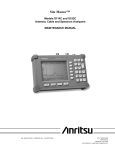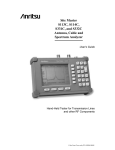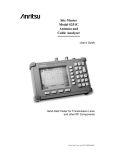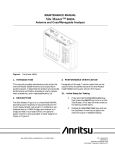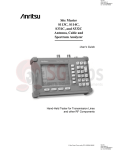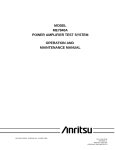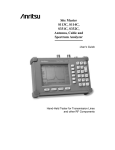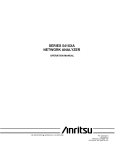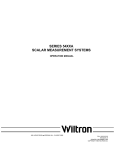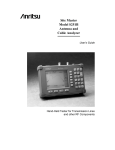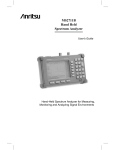Download Anritsu S113C User`s guide
Transcript
MAINTENANCE MANUAL Site Master™ Models S113C, S331C and S115BQ Antenna and Cable Analyzers Figure 1. 1. Site Master Model S331C INTRODUCTION This manual provides maintenance instructions for the Site Master S113C/S331C and S115BQ Antenna and Cable Analyzer. It describes the product and provides performance verification procedures, parts replacement procedures, and a replaceable parts list. 3. Paragraphs 4 through 9 contain tests that can be used to verify the performance of the Site Master models S113C/ S331C and S115BQ having any version of firmware. 3.1. 2. PERFORMANCE VERIFICATION Initial Setup for Testing DESCRIPTION The Site Master (Figure 1) is a hand held SWR/RL (standing wave ratio/return loss), and Distance-To-Fault measurement instrument. It combines a synthesized source, VSWR Bridge, and receiver on a single printed circuit board (PCB). An optional power monitor is also available. A block diagram is shown in Figure 2. 490 JARVIS DRIVE · MORGAN HILL, CA 95037-2809 1. Press and hold the ESCAPE/CLEAR key, then press the ON/OFF key to turn on the Site Master. (This sets the instrument to the factory preset state.) 2. Release the ESCAPE/CLEAR key and use the Up/Down arrow key to adjust the contrast to give a readable display. P/N: 10580-00062 REVISION A PRINTED: FEBRUARY 2002 COPYRIGHT 2002 ANRITSU CO. C o u p le r D iv id e r / M u ltip lie r R F S o u rc e x T e s t P o rt x L O S D S D A D C D is p la y Figure 2. 4. The following test can be used to verify the CW frequency accuracy of the Site Master. Measurement calibration of the Site Master is not required for this test. 2. Press the FREQ/DIST key, then press the F1 soft key and set F1 to 1000 MHz, then press the ENTER key. 3. Press the F2 soft key, set F2 to 1000 MHz, then press the ENTER key. 4. Connect the RF cable from the Site Master Reflection Test Port to the RF Input on the MS2663C or equivalent. 5. Set up the Spectrum Analyzer as follows: Equipment Required: · Spectrum Analyzer Anritsu Model MS2663C or equivalent b. S e r ia l P o rt Site Master Block Diagram FREQUENCY ACCURACY a. C P U Procedure: (a) Press the Preset key, then select Preset All (F1). (b) Press the Frequency key. 1. Press and hold the ESCAPE/CLEAR key, then press the ON/OFF key to turn on the Site Master. (This sets the instrument to the factory preset state.) NOTE Before continuing, allow a five minute warm up for the internal circuitry to stabilize. 2 (c) Press the 1 key and then the GHz key to change the Center Frequency to 1 GHz. (d) Press the Span key. (e) Press the 7, 5, 0, and kHz keys sequentially to change the Frequency Span to 750 kHz. (f) Press the RBW key. Site Master S113C/S331C/S115BQ MM (g) Press the 1, 0 and kHz keys sequentially to change the RBW to 10 kHz. 5. (h) Press the VBW key. The following test can be used to verify the accuracy of return loss measurements. Measurement calibration of the Site Master is required for this test. (i) Press the Filter Off soft key (F3) to turn the VB filter off. (j) Press the Amplitude key. RETURN LOSS VERIFICATION a. Equipment Required: · 20 dB offset, Anritsu SC5270 (k) Press the 1, 0, and dBm keys sequentially to change the Reference Level to 10 dBm. · 6 dB offset, Anritsu SC5237 · Open/Short, Anritsu 22N50 (l) Press the Log Scale soft key (F5) · 50 Ohm Termination, Anritsu 28N50-2 or SM/PL (m) Select 2 dB/Div (F3) and the press the return soft key (F6). (n) Press the Marker key. (o) Press the Zone Width soft key (F5). (p) Select the Spot soft key (F1). 6. 7. On the Spectrum Analyzer, press the A, B and then the Storage key (F5). 8. Press the Max Hold soft key (F2). 9. A peak response should appear on the Spectrum Analyzer. 11. Procedure: 1. On the Site Master, press the SYS key, the OPTIONS soft key and then the FIXED CW soft key to turn Fixed CW on. NOTE: If the Site Master has gone into the hold mode, press the RUN/HOLD key to return to normal mode. 10. b. Press the Marker Peak Search key on the Spectrum Analyzer. Verify that the marker peak readout value is 1000 MHz ±75 kHz. Press and hold the ESCAPE/CLEAR key, then press the ON/OFF key to turn on the Site Master. (This sets the instrument to the factory preset state.) NOTE Before continuing, allow a five minute warm up for the internal circuitry to stabilize. 2. Press the MODE soft key. 3. Use the Up/Down Arrow key to highlight RETURN LOSS, then press ENTER. 4. Press the START CAL key. 5. Follow the instructions on the screen to perform a calibration using a 22N50 Open/Short and 28N50-2 or SM/PL Termination. 6. Connect the 20 dB offset to the Refl Test Port and verify that the reading is: q S113C/S115BQ: 20 dB ± 1.7 dB On the Site Master, press the SYS key, the OPTIONS soft key and then the FIXED CW soft key to turn Fixed CW Off. q S331C: 20 dB ± 1.7 dB 7. Connect the 6 dB offset to the Refl Test Port and verify that the reading is: q S113C/S115BQ: 6 dB ± 1.2 dB q S331C: 6 dB ± 1.2 dB. Site Master S113C/S331C/S115BQ MM 3 Attenuators 560-7N50B RF Detector MA2418A Reference Source 50 MHz, 50 W 0dBm 15-24V DC 20 mA MA2418A Reference Source Site Master S331C 1 2 START CAL AUTO SCALE SAVE SETUP RECALL SETUP 3 5 LIMIT 7 SAVE DISPLAY 9 ON OFF MODE FREQ/DIST AMPLITUDE ESCAPE CLEAR 4 6 DC Power Supply 2000-933 MARKER 8 RECALL DISPLAY 0 ENTER RUN HOLD +/- PRINT . SYS SWEEP Site Master w/ Option 5 Installed Figure 3. 6. Power Monitor Verification 4. Connect the DC power supply to the appropriate line voltage to supply power to the MA2418A Reference Source. 5. Press and hold the ESCAPE/CLEAR key, then press the ON/OFF key to turn on the Site Master. (This sets the instrument to the factory preset state.) 6. Press the MODE soft key. · RF Detector, 10 MHz to 20 GHz, Anritsu 560-7N50C 7. Use the Up/Down Arrow key to highlight POWER MONITOR, then press ENTER. · 10 dB Attenuator, Weinschel 1-10 8. Press the ZERO soft key to zero the power monitor. When complete, ZERO ADJ:ON is displayed in the message area. 9. Verify that the power monitor reading is 0.0 dBm ± 1 dB. 10. Connect the output of the MA2418A Reference Source to the two attenuators so as to add 40 dB of attenuation (Figure 3). POWER MONITOR VERIFICATION If the Power Monitor (Option 5) is installed in the Site Master, the following test can be used to verify the accuracy of the power measurements. Measurement calibration of the Site Master is not required for this test. a. Equipment Required: · 30 dB Attenuator, Weinschel 1-30 · RF Reference Source, 0.050 GHz, Anritsu MA2418A · DC Power Supply, Anritsu 2000-933 b. 4 Procedure 1. Connect the DC power supply to the MA2418A Reference Source. (Refer to Figure 3, page 4.) 11. Connect the MA2418A Reference Source and the attenuators to the input of the 560-7N50C RF detector. 2. Connect the MA2418A Reference Source to the input of the 560-7N50C RF detector. 12. Verify that the power monitor reading is now –40.0 dBm ±2 dB. 3. Connect the RF Detector output to the RF Detector input of the Site Master. Site Master S113C/S331C/S115BQ MM 7. INSTACAL MODULE VERIFICATION This test verifies the performance of the Anritsu Site Master InstaCal Calibration Module. The InstaCal Module, part number ICN50, is an optional accessory for the S113C, S331C, and S115BQ. NOTE Full verification of the InstaCal module over its entire frequency range (2 - 4000 MHz) requires both an S113C (or S115BQ) and an S331C Site Master. However, limited verification is possible with either instrument for the frequency range of that instrument only. The frequency range of the S113C and S115BQ is 2 to 1600 MHz. The frequency range of the S331C is 25 to 4000 MHz. a. Equipment Required: · InstaCal Module, part number ICN50 · 20 dB offset, Anritsu SC5270 · 6 dB offset, Anritsu SC5237 b. Procedure NOTE If performing full verification over the entire frequency range with both an S113C (or S115BQ) and an S331C Site Master, perform this procedure first on the S113C (or S115BQ) and then on the S331C. 1. Press and hold the ESCAPE/CLEAR key, then press the ON/OFF key to turn on the Site Master. (This sets the instrument to the factory preset state.) NOTE Before continuing, allow a five minute warm up for the internal circuitry to stabilize. 2. Press the MODE soft key. 3. Use the Up/Down Arrow key to highlight RETURN LOSS, then press ENTER. 4. Press the START CAL key. The message “CONNECT OPEN or InstaCal TO RF Out PORT” will appear in the display. 5. Connect the InstaCal module to the RF Out port and press the ENTER key. Site Master S113C/S331C/S115BQ MM NOTE If this particular InstaCal module has been used to calibrate this Site Master before, the Site Master senses the familiar InstaCal module and automatically calibrates the unit using the OSL procedure. If the Site Master senses that the characterization data for the InstaCal module connected to this Site Master is different than the one currently stored, it will display soft key options to keep or replace the InstaCal characterization data. Selecting the YES soft key transfers all of the characterization data from this InstaCal module to the Site Master. The transfer may take up to three minutes. This option is preferred if this InstaCal module is to stay with this particular Site Master. Once completed, the data will not need to be transfered again for this combination of Site Master and InstaCal module. Selecting the NO soft key will temporarily transfer only the portion of the characterization data necessary for this particular calibration. This transfer takes aproximately 30 to 60 seconds, and will have to be repeated every time a calibration is done using this combination of Site Master and InstaCal module. 6. Verify that the calibration has been properly performed by checking that the CAL ON! message is displayed in the upper left corner of the display. 7. Remove the InstaCal module from the RF Out port and connect the 20 dB Offset to the RF Out port. 8. Measure the return loss of the 20 dB Offset. The level should be 20 dB, ±2 dB across the calibrated frequency range. 9. Remove the 20 dB Offset from the RF Out port and connect the 6 dB Offset to the RF Out port. 10. Measure the return loss of the 6 dB Offset. The level should be 6 dB, ±1.2 dB across the calibrated frequency range. 5 Open/Short 50 Ohm Termination Termination under Test 541XXA Scalar Measurement System Beadless End Precision Air Line Connect Dashed Line Connections When Directed By Procedure A B Source Adapter Figure 4. 8. 541XXA Precision Return Loss Setup TERMINATION VERIFICATION This test verifies the accuracy of the Site Master SM/PL termination using the precision return loss mode of the 541XXA Scalar Measurement System. Measurements of terminations using this mode provide results that are traceable to the NIST (National Institute of Standards and Technology) standards for the precision airline. a. Offset SWR Autotester 4. Using the Menu up-down keys: Highlight RESET, then press the Select key. 5. At the RESET MENU display, use the Menu up-down keys to highlight RESET TO FACTORY DEFAULTS, then press the Select key. 6. Set the signal source for the frequency range as follows: (a) Press the Frequency key. Equipment Required: (b) Using the Data Entry Keypad or Data Entry Knob, set the Start frequency to 0.01 GHz. Press the Enter key. · Scalar Measurement System, Anritsu 541XXA · Offset SWR Autotester, Anritsu 560-97A50-20 (c) Using the Data Entry Keypad or Data Entry Knob, set the Stop frequency to 4.0 GHz. Press the Enter key. · Precision Airline, Anritsu 18N50 · Open/Short, Anritsu 22N50 · 50 Ohm Termination, Anritsu 28N50-2 7. Press the Channel 2 Display On/Off key to Off. 8. Press the Channel 1 Menu key. 9. Using the Menu up-down keys: Highlight PRECISION RL, then press the Select key. · Source Adapter, Anritsu 34NN50A b. Procedure 1. 6 Connect the test equipment as shown in Figure 4, page 6. 2. Press the Power key on the 541XXA to On. 3. Press the System Menu key. 10. At the PRECISION RETURN LOSS menu display, use the Menu up-down keys to highlight FINAL, then press the Select key. Site Master S113C/S331C/S115BQ MM 11. Press the Calibration key. 12. At the CALIBRATION menu display, use the Menu up-down keys to highlight START CAL, then press the Select key. 13. At the PRECISION RETURN LOSS CALIBRATION menu display prompt, connect the Offset SWR Autotester to Input A, if you have not done so yet. 14. CAUTION During both calibration and measurement, be sure to properly align the bead-less connector of the airline. When the connectors are mis-aligned, a spike will usually be visible on the display. Connect the precision air line to the Offset SWR Autotester test port. Position the air line pointing vertically upward. Downward or horizontal positions make connector pin alignment difficult. NOTE Ensure that the bead-less end of the precision airline is at the measurement connection point. 18. At the next menu prompt, remove the Open and connect the Short to the bead-less end of the airline. Press the Select key to start the calibration process. 19. At the next menu prompt, remove the Short and connect the 50 Ohm Termination to the bead-less end of the air line. Press the Select key to start the calibration process. 20. When the calibration is complete, remove the 50 Ohm Termination. 15. Press the Select key when ready. 21. 16. At the PRECISION RETURN LOSS CALIBRATION menu prompt, connect the Open to the bead-less end of the airline. Press the Select key to start the calibration. Connect the SM/PL termination to the bead-less end of the air line and press the Select key to begin the measurement. 22. Observe that the waveform displayed resembles that shown in Figure 6. 17. Verify that the display resembles that shown in Figure 5. 1 : P R E C S N R L (A ) 2 : O F F 1 0 .0 d B /D IV O F F S E T + 0 .0 d B 1 : P R E C S N R L (A ) 2 : O F F 1 0 .0 d B /D IV O F F S E T + 0 .0 d B C U R S O R 5 4 1 4 7 A 1 : -4 6 .0 2 d B P R E C IS IO N R E T U R N L O S S C A L IB R A T IO N 5 4 1 4 7 A 2 .4 0 5 0 G H z C O N N E C T O P E N T O A IR L IN E P R E S S S E L E C T F O R C U R S O R M E N U S T A R T : 0 .0 1 0 0 G H z P R E S S S E L E C T W H E N R E A D Y S T A R T : 0 .0 1 0 0 G H z 4 0 1 p ts Figure 5. 0 .4 G H z /D IV S T O P : 4 .0 0 0 0 G H z L E V E L + 7 .0 d B m Example of a Good Connection Site Master S113C/S331C/S115BQ MM 4 0 1 p ts Figure 6. 0 .4 G H z /D IV S T O P : 4 .0 0 0 0 G H z L E V E L + 7 .0 d B m Direct Readout of the Precision Return Loss 23. Press the Cursor On/Off key to On. 24. Observe the Cursor menu readout. The minimum return loss reading for the SM/PL termination should be 42 dB. 7 9. BATTERY PACK REMOVAL AND REPLACEMENT This procedure provides instructions for removing and replacing the Site Master battery pack. 1. With the Site Master standing upright on a stable surface, locate the battery access door (Figure 7). BATTERY ACCESS DOOR Figure 9. Figure 7. 2. Battery Access Door Location Lift up the access door handle and rotate it 90 degrees counterclockwise, as illustrated in Figure 8. Figure 10. 5. Figure 8. Removing the Battery Replacement is the opposite of removal. Note the orientation of the battery contacts, and be sure to insert the new battery with the contacts facing the rear of the unit (Figure 10). Rotate the Battery Access Door Handle 3. Lift the door and remove, as illustrated in Figure 11. 4. Grasp the battery lanyard and pull the battery straight up and out of the unit, as illustrated in Figure 9. BATTERY CONTACTS Figure 11. 8 Removing the Battery Access Door Battery Orientation Site Master S113C/S331C/S115BQ MM 10. BATTERY INFORMATION The following information relates to the care and handling of the Site Master battery, and NiMH batteries in general. · The Nickel Metal Hydride (NiMH) battery supplied with the Site Master is shipped in a discharged state. Before using the Site Master, the internal battery must first be charged for three hours, either in the Site Master or in the optional battery charger (Anritsu part number: 2000-1029). · Use only Anritsu approved battery packs. · Batteries must be recycled or disposed of properly. Do not place batteries in household garbage. · Always use the battery for its intended purpose only. 10.1. Battery Testing Procedure 1. 2. · Recharge the battery only in the Site Master or in an Anritsu approved charger. · With a new NiMH battery, full performance is achieved after three to five complete charge and discharge cycles. Disconnect the AC-DC Adapter when the Battery Charging LED turns off, indicating the battery is fully charged. 3. Press and hold the ESCAPE/CLEAR key, then press the ON/OFF key to turn on the Site Master. This sets the instrument to the factory preset state. Press ENTER when prompted to continue. 4. Press the SYS key, followed by the STATUS soft key. Verify that the indicated battery charge is ³ 80%. If the value is 80% or above, press the ESCAPE/CLEAR key and continue with this procedure. · When the Site Master or the charger is not in use, disconnect it from the power source. · Do not charge batteries for longer than 24 hours; overcharging may shorten battery life. With the Site Master off and the battery installed, connect the Universal AC Adapter to the 12.5-15VDC (1100 mA) connector. The External Power LED and the Battery Charging LED will light. · If left unused a fully charged battery will discharge itself over time. · Temperature extremes will affect the ability of the battery to charge: allow the battery to cool down or warm up as necessary before use or charging. If the value is lower than 80%, a discharge/charge cycle may be needed to improve the battery capacity. Completely discharge the battery, as described in Steps 5 and 6 below, and then recharge the battery as described in Steps 1 and 2. If the battery capacity does not increase after a discharge/charge cycle, replace the battery. · Discharge an NiMH battery from time to time to improve battery performance and battery life. · The battery can be charged and discharged hundreds of times, but it will eventually wear out. · The battery may need to be replaced when the operating time between charging becomes noticeably shorter than normal. 5. Press the START CAL key (to keep the Site Master from going into HOLD mode) and make note of the test start time. · Never use a damaged or worn out charger or battery. 6. When the Site Master display fades and the Site Master switches itself off, make note of the test stop time. 7. The total test time (Step 5 to Step 6) should be ³ 2.5 hours. If the total test time is <2.5 hours, replace the battery. · Storing the battery in extreme hot or cold places will reduce the capacity and lifetime of the battery. · Never short-circuit the battery terminals. · Do not drop, mutilate or attempt to disassemble the battery. · Do not dispose of batteries in a fire! Site Master S113C/S331C/S115BQ MM 9 11. FRONT PANEL ASSEMBLY REMOVAL AND REPLACEMENT 7. Carefully disconnect the LCD display backlight cable from J15 on the main PCB. This procedure provides instructions for removing and replacing the Site Master front panel assembly. With the front panel assembly removed, the LCD display, keypad PCB, keypad membrane, and main PCB assemblies can be removed and replaced. J15 J4 1. Place the Site Master face up on a work surface. 2. Remove the four rubber corner bumpers by carefully sliding the bumpers off of the case corners (Figure 15). J12 Figure 13. Figure 12. 3. 4. Removing the Corner Bumpers 8. Remove the front panel assembly. 9. Reverse the above steps to replace the front panel assembly. NOTE The corner bumpers only mount one way. That is, the raised area inside one end of the bumper (Figure 13) is made to conform to the contour of the front cover only. With the bumpers removed, the access holes for the case screws are revealed. Use a Phillips screwdriver to remove the four screws securing the two halves of the Site Master case together. RAISED AREA Carefully lift up on the right side (as viewed from the front) of the front half of the case and begin to separate the two halves. CAUTION Do not force or pull the two halves of the case apart as there are delicate cables attached between the two halves that must be disconnected first. 10 Corner Bumper Detail 5. Carefully depress the latch tab and disconnect the LCD display cable from J12 on the main PCB. 6. Carefully disconnect the keypad interface cable from J4 on the main PCB. Figure 14. Site Master Front Panel Cable Connections Site Master S113C/S331C/S115BQ MM 12. LCD ASSEMBLY REPLACEMENT 13. KEY PAD PCB REPLACEMENT This procedure provides instructions for removing and replacing the Liquid Crystal Display (LCD) once the front panel assembly has been separated from the Site Master. This procedure provides instructions for removing and replacing the key pad PCB. 1. 2. 3. 4. 1. Remove the front panel assembly as directed in section 11. Remove the front panel assembly as directed in section 11. 2. Place the front panel assembly face down on a protected work surface. Place the front panel assembly face down on a protected work surface. 3. Remove the 14 Phillips screws that attach the backing plate to the front panel assembly. Remove the 14 Phillips screws that attach the backing plate to the front panel assembly. 4. Release the LCD display cable from the retaining clip on the front panel backing plate (Figure ). 5. Remove the front panel backing plate, carefully feeding the LCD cable through the access hole to avoid damage to the cable or connector. 6. Remove the rubber cushion pad from the key pad PCB and remove the PCB. Release the LCD display cable from the retaining clip on the front panel backing plate. FRONT PANEL BACKING PLATE LCD CABLE RETAINING CLIP KEYPAD PCB Figure 15. Front Panel Backing Plate 5. Remove the front panel backing plate, carefully feeding the LCD cable through the access hole to avoid damage to the cable or connector. 6. Remove the rubber cushion pad from the LCD assembly and remove the assembly. 7. Reverse the above steps to install the replacement assembly. Site Master S113C/S331C/S115BQ MM Figure 16. 7. Front Panel Keypad PCB Location Reverse the above steps to install the replacement assembly. 11 14. KEY PAD MEMBRANE REPLACEMENT 15. MAIN PCB ASSEMBLY REPLACEMENT This procedure provides instructions for replacing the key pad membrane. This procedure provides instructions for replacing the main PCB assembly with the connector panel attached. 1. Remove the front panel assembly as directed in section 11. 2. Remove the key pad PCB as directed in section 13. 3. Remove the keypad membrane by gently pulling the membrane up and out of the holes in the front panel. NOTE The lithium-coin clock battery (part number 633-26) on the main PCB may be replaced as necessary without replacing the entire PCB. 1. Remove the front panel assembly as directed in section 11. 2. Disconnect the battery connector from J13 on the main PCB. 3. Remove the three PCB mounting screws and remove the PCB assembly with the connector panel attached. KEYPAD MEMBRANE CLOCK BATTERY J13 BATTERY ONNECTOR Figure 17. 4. Front Panel Keypad Membrane Reverse the above steps to install the replacement membrane. PCB MOUNTING SCREWS (3) Figure 18. 4. Main PCB Reverse the above steps to install the new main PCB. NOTE The main PCB connector panel fits into grooves in the two halves of the Site Master case. Make sure the panel is correctly aligned with the grooves before reassembling the two halves together. 12 Site Master S113C/S331C/S115BQ MM 16. REPLACEABLE PARTS Replaceable parts for the Site Master Model S113C/S331C and S115BQ are listed below. Table 1. Replaceable Parts List Part Number Description Qty Part Number Description Qty Hardware Accessories 900-861 Pan Head Screw, 4-20, 0.365 15 900-869 Screw, 4-40, 0.875 4 900-720 Screw, 4-40, 0.187 3 900-697 Screw, 4-40, 0.312 3 1 785-929 M-F Stand off, 4-40, 11/16 3 Universal AC Adapter 1 900-326 Kep Nut, 4-40, 0.187 8 2000-1029 Battery Charger 1 790-516 Hole Plug, 0.6875L 1 22N50 Precision Short/Open, N Male 1 790-42 Hole Plug, 0.625 1 SM/PL Precision RF Terminator, N Male 1 761-79 Cap Vinyl, Black, round 1 OSLN50LF Precision Open/Short/Load, N Male 1 806-62 Cable Assy, Cig Plug, Female 1 46652-1 Top Case only, S113C/S331C 1 800-441 Serial Interface Cable Assy 1 46652-2 Top Case only, S115BQ 1 48258 Soft Carrying Case 1 46653-1 Bottom Case only 1 48297 Plastic Display Window, S115BQ 1 48231-1 Battery Door 1 Battery Door Latch (3 pieces) 10580-00060 User's Guide, Site Master S113C, S114C, S331C, S332C 1 10580-00061 Programming Manual, Site Master S113C, S114C, S331C, S332C (available on disk only) 1 2300-347 Software Tools CD, Site Master 40-115 Replaceable Parts Case Parts 510-87 N-Connector 1 ND57371 Option 05 Input Connector with cable 1 790-509 790-510 790-511 15-102 Liquid Crystal Display Assy 1 46655 Case Corner Bumpers 4 633-27 Rechargeable Battery, NiMH 1 46662 LCD Retainer Plate 1 ND57959 Main PCB Assembly, S113C 1 48241 Foam, LCD Corners 8 ND57963 Main PCB Assembly, S331C 1 48278 Foam, LCD Window 1 ND57960 Main PCB Assembly, S113C with Option 05 1 46659 Foam, LCD Backing 1 46661 Foam, Keypad Backing 1 ND57964 Main PCB Assembly, S331C with Option 05 1 48246 Foam, Battery Door 4 47812-3 Keypad PCB Assy 1 720-19 Cable Clamp 1 46649-1 Membrane Keypad, Main 1 790-515 Spring, Battery Compartment 3 633-26 Lithium Coin Clock Battery 1 55216 ID Label, Model S113C 1 55223 ID Label, Model S331C 1 55224 ID Label, Model S115BQ 1 Site Master S113C/S331C/S115BQ MM 1 13 NOTES Table 2. Anritsu Service Centers UNITED STATES FRANCE SINGAPORE ANRITSU COMPANY 685 Jarvis Drive Morgan Hill, CA 95037-2809 Telephone: (408) 776-8300 FAX: 408-776-1744 ANRITSU S.A 9 Avenue du Quebec Zone de Courtaboeuf 91951 Les Ulis Cedex Telephone: 016-09-21-550 FAX: 016-44-61-065 ANRITSU (SINGAPORE) PTE LTD 10, Hoe Chiang Road #07-01/02 Keppel Towers Singapore 089315 Tel:65-282-2400 Fax:65-282-2533 ANRITSU COMPANY 10 NewMaple Ave., Unit 305 Pine Brook, NJ 07058 Telephone: (201) 227-8999 FAX: 201-575-0092 ANRITSU COMPANY 1155 E. Collins Blvd Richardson, TX 75081 Telephone: 1-800-ANRITSU FAX: 972-671-1877 AUSTRALIA ANRITSU PTY. LTD. Unit 3, 170 Foster Road Mt Waverley, VIC 3149 Australia Telephone: 03-9558-8177 FAX: 03-9558-8255 BRAZIL ANRITSU ELECTRONICA LTDA. Praia de Botafogo 440. Sala 2401 CEP22250-040,Rio de Janeiro,RJ, Brasil Telephone: 021-527-6922 Fax: 021-53-71-456 CANADA ANRITSU INSTRUMENTS LTD. 215 Stafford Road, Unit 102 Nepean, Ontario K2H 9C1 Telephone: (613) 828-4090 FAX: (613) 828-5400 CHINA (SHANGHAI) ANRITSU ELECTRONICS CO LTD 2F,Rm.B, 52 Section Factory Bldg. NO 516 Fu Te Road (N) Waigaoqiao Free Trade Zone Pudong, Shanghai 200131 PR CHINA Telephone: 86-21-58680226 FAX: 86-21-58680588 GERMANY ANRITSU GmbH Grafenberger Allee 54-56 D-40237 Dusseldorf Germany Telephone: 0211-968550 FAX: 0211-9685555 SOUTH AFRICA ETESCSA 12 Surrey Square Office Park 330 Surrey Avenue Ferndale, Randburt, 2194 South Africa Telephone: 011-27-11-787-7200 Fax: 011-27-11-787-0446 INDIA MEERA AGENCIES (P) LTD A-23 Hauz Khas New Delhi, India 110 016 Telephone: 011-685-3959 FAX: 011-686-6720 ISRAEL TECH-CENT, LTD 4 Raul Valenberg St. Tel-Aviv, Israel 69719 Telephone: 972-36-478563 FAX: 972-36-478334 ITALY ANRITSU Sp.A Rome Office Via E. Vittorini, 129 00144 Roma EUR Telephone: (06) 50-2299-711 FAX: 06-50-22-4252 JAPAN ANRITSU CUSTOMER SERVICE LTD. 1800 Onna Atsugi—shi Kanagawa-Prf. 243 Japan Telephone: 0462-96-6688 FAX: 0462-25-8379 KOREA ANRITSU SERVICE CENTER 8F Sanwon Bldg. 1329-8 Seocho-Dong Seocho-Ku Seoul, Korea 137-070 Telephone: 82-2-581-6603 FAX: 82-2-582-6603 SWEDEN ANRITSU AB Botvid Center Fittja Backe 13A 145 84 Stockholm, Sweden Telephone: (08) 534-707-00 FAX: (08)534-707-30 TAIWAN ANRITSU CO., LTD. 6F, No. 96, Section 3 Chien Kuo N. Road Taipei, Taiwan, R.O.C. Telephone: (02) 515-6050 FAX: (02) 509-5519 UNITED KINGDOM ANRITSU LTD. 200 Capability Green Luton, Bedfordshire LU1 3LU, England Telephone: 015-82-43-3200 FAX: 015-82-73-1303
















